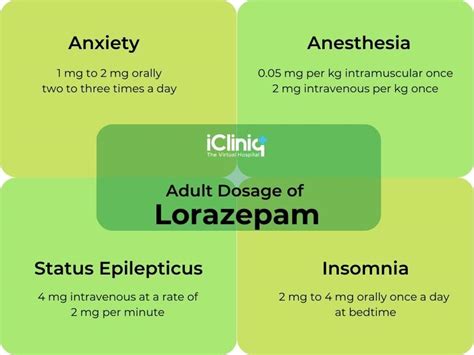Intro
Discover 5 uses of Lorazepam, a potent anxiety medication, for treating insomnia, seizures, and panic attacks, with benefits including sedation, relaxation, and anti-anxiety effects.
Lorazepam, commonly known by its brand name Ativan, is a medication that belongs to the benzodiazepine class. It is widely used for its tranquilizing effects, which make it a versatile drug in the management of various medical conditions. The importance of understanding lorazepam's uses cannot be overstated, as it is a prescription medication that should be used under the guidance of a healthcare professional. Its applications span across different fields of medicine, including psychiatry, neurology, and anesthesiology. The drug's efficacy in treating anxiety disorders, insomnia, and seizures, among other conditions, has made it a staple in many treatment plans.
Lorazepam's mechanism of action involves enhancing the effects of gamma-aminobutyric acid (GABA) in the brain, which is a neurotransmitter that inhibits brain activity. This results in a calming effect on the nervous system, making lorazepam useful for treating conditions characterized by excessive neuronal activity. The drug's onset of action is relatively quick, which is beneficial in emergency situations or when rapid relief from symptoms is needed. However, like all benzodiazepines, lorazepam carries the risk of dependence and withdrawal, emphasizing the need for careful prescription and monitoring.
The versatility of lorazepam is evident in its wide range of applications. From managing acute anxiety and insomnia to its use in the treatment of status epilepticus, lorazepam has proven to be a valuable pharmacological agent. Its use extends beyond these conditions, highlighting the drug's broad therapeutic index. Understanding the full spectrum of lorazepam's uses is crucial for healthcare professionals and patients alike, ensuring that the medication is used effectively and safely.
Medical Uses of Lorazepam

Lorazepam's medical uses are diverse and include the treatment of anxiety disorders, insomnia, seizures, and as a premedication for surgical procedures. In the context of anxiety disorders, lorazepam is particularly useful for short-term relief of severe anxiety. It is effective in managing symptoms of generalized anxiety disorder, panic disorders, and social anxiety disorder. For insomnia, lorazepam can help individuals fall asleep and stay asleep, although it is generally recommended for short-term use due to the risk of dependence.
Anxiety Disorders
Lorazepam is commonly prescribed for anxiety disorders due to its rapid onset of action and efficacy in reducing symptoms of anxiety. It works by enhancing the effect of GABA, which leads to a calming effect on the nervous system. This makes lorazepam particularly useful in acute anxiety situations where quick relief is necessary.Benefits and Side Effects

The benefits of lorazepam include its effectiveness in treating a range of conditions, its quick onset of action, and its availability in various formulations, including oral tablets, injectables, and sublingual tablets. However, like all medications, lorazepam is not without side effects. Common side effects include drowsiness, dizziness, blurred vision, and impaired coordination. More serious side effects can include respiratory depression, especially when combined with other central nervous system depressants, and paradoxical reactions such as agitation and aggression.
Working Mechanism
The working mechanism of lorazepam involves the potentiation of GABA, the primary inhibitory neurotransmitter in the brain. By enhancing GABA's effect, lorazepam increases the inhibitory effects on the nervous system, leading to a calming effect. This mechanism is responsible for lorazepam's anxiolytic, sedative, muscle relaxant, and anticonvulsant properties.Steps for Safe Use

To ensure the safe use of lorazepam, patients should follow their prescription carefully and attend all scheduled follow-up appointments with their healthcare provider. It is crucial to inform your healthcare provider about all medications you are currently taking, including over-the-counter drugs and supplements, to avoid potential drug interactions. Lorazepam should not be stopped abruptly, as this can lead to withdrawal symptoms. Instead, the dose should be gradually tapered under the guidance of a healthcare professional.
Practical Examples and Statistical Data
Practical examples of lorazepam's effectiveness can be seen in clinical settings where it is used to manage acute anxiety and seizures. Statistical data from clinical trials have consistently shown that lorazepam is effective in reducing symptoms of anxiety and improving sleep quality in individuals with insomnia. For instance, a study published in a medical journal found that lorazepam significantly reduced the time to fall asleep and improved sleep duration in patients with chronic insomnia.FAQs on Lorazepam

What is lorazepam used for?
+Lorazepam is used for the treatment of anxiety disorders, insomnia, seizures, and as a premedication for surgical procedures.
How does lorazepam work?
+Lorazepam works by enhancing the effect of gamma-aminobutyric acid (GABA) in the brain, leading to a calming effect on the nervous system.
What are the common side effects of lorazepam?
+Common side effects of lorazepam include drowsiness, dizziness, blurred vision, and impaired coordination.
Conclusion and Future Directions

In conclusion, lorazepam is a versatile medication with a wide range of applications in medicine. Its effectiveness in treating anxiety disorders, insomnia, and seizures, among other conditions, has made it a valuable pharmacological agent. However, its use must be carefully managed due to the risk of dependence and withdrawal. Future research directions may include exploring new formulations of lorazepam that reduce the risk of dependence and investigating its potential use in other medical conditions.
Final Thoughts
As we reflect on the uses and benefits of lorazepam, it is essential to remember that this medication should be used under the guidance of a healthcare professional. By understanding its mechanism of action, benefits, and potential side effects, patients can make informed decisions about their treatment plan. If you have any questions or concerns about lorazepam or any other medication, do not hesitate to reach out to your healthcare provider.We invite you to share your thoughts and experiences with lorazepam in the comments below. Your input can help others better understand the benefits and challenges of using this medication. Additionally, if you found this article informative, please consider sharing it with others who may benefit from this information. Together, we can promote safe and effective use of medications like lorazepam.
